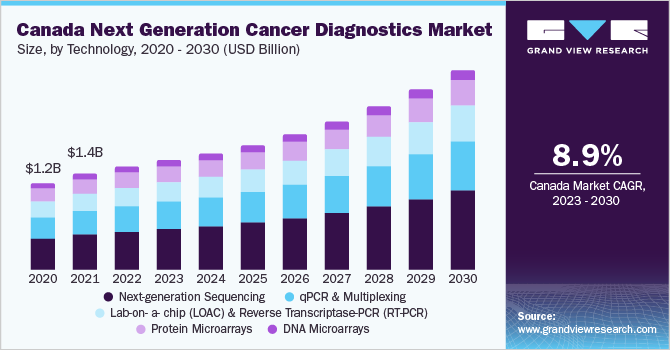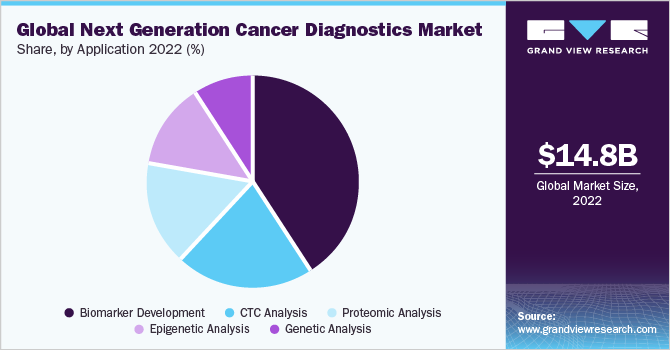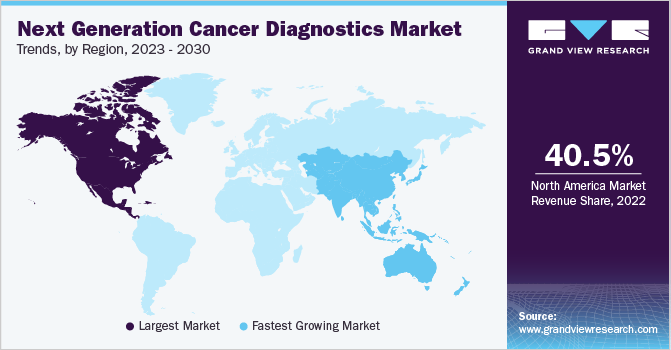- Home
- »
- Clinical Diagnostics
- »
-
Next Generation Cancer Diagnostics Market Report, 2030GVR Report cover
![Next Generation Cancer Diagnostics Market Size, Share & Trends Report]()
Next Generation Cancer Diagnostics Market Size, Share & Trends Analysis Report By Technology (LOAC & RT-PCR, Protein Microarrays), By Application, By Cancer Type, By Function, By Region, And Segment Forecasts, 2023 - 2030
- Report ID: 978-1-68038-738-4
- Number of Report Pages: 236
- Format: PDF, Horizon Databook
- Historical Range: 2018 - 2021
- Forecast Period: 2023 - 2030
- Industry: Healthcare
Report Overview
The global next generation cancer diagnostics market size was estimated at USD 14.84 billion in 2022 and is projected to grow at a compound annual growth rate (CAGR) of 9.3% from 2023 to 2030. The growth is anticipated to be driven by the rising incidence of oncology diseases, the need for efficient prognosis and early diagnosis of various forms of cancer, and rising initiatives by key players in the development of innovative solutions to meet the increasing demand for efficient diagnostics. Several tests, including physical examination, laboratory tests, imaging tests, and biopsies have traditionally been performed in cancer diagnosis. Each step of the usual diagnostic procedure with the prognosis and therapeutic decision made by oncologists comes with a well-defined diagnosis to avoid potential complications. This highlights the crucial importance of diagnosis throughout the entire oncology lifecycle, surpassing the therapeutic regime's significance.

The diagnosis of cancer not only helps initiate an appropriate therapeutic regime but also plays a vital role in monitoring the progression of the disease, allowing for necessary adjustments to the treatment approach. Early diagnosis is particularly critical as it offers the best chances for successful treatment, reducing the risks associated with lower survival rates, treatment complexities, and higher medical expenses due to disease progression. Therefore, early diagnosis is considered an important public health strategy. Within diagnostics, the detection of cancer biomarkers represents a rapidly growing field of clinical diagnostics. These biomarkers assist in predicting prognosis, assessing therapy response, and monitoring patients after primary treatment.
In January 2023, the European Cancer Imaging Initiative was launched at an event in Brussels by the Commission with the purpose to provide support to healthcare providers, research institutes, and innovators in maximizing the utilization of innovative data-driven solutions for treatment and care. Europe's Beating Cancer Plan as a flagship action under the initiative aims to establish a digital infrastructure that connects resources and databases of cancer imaging data across the European Union (EU). Throughout this process, strict adherence to high ethical standards, trust, security, and personal data protection is set to be ensured. In addition, the initiative will facilitate the connection between EU-level and national initiatives, hospital networks, research repositories, and other relevant health data, including imaging data.
In addition, following the launch of the European Cancer Imaging Initiative, which includes the EUCAIM project and the AI Testing and Experimentation Facility for Health (TEF-Health), it is anticipated that, by December 2023, the design of the pan-European digital infrastructure is anticipated to be completed along with the collaboration mechanism. At that point, data providers will have the ability to connect with this new European federate platform’s first version is expected to be released by the end of 2024, and the final release is projected to be completed by the end of 2025. The digital infrastructure is scheduled to be fully operational and running by 2026.
The growth of the market is significantly hampered by the need for substantial economic investment, skill, and time required for the deployment of analytical instrumentation and infrastructure for laboratory analysis of cancer samples. This is particularly evident in the setup of expensive equipment such as MRI, PET, SPECT, and next-generation sequencing platforms. Furthermore, these products have not been proven to be economically viable even after being associated withhigh costs associated with their development and implementation. This uncertainty is one of the major factors restraining the growth of the market.
Technology Insights
Based on the technology, next-generation sequencing (NGS) technology dominated the market with a revenue share of 36.55% in 2022 and is anticipated to grow with the fastest CAGR of 10.4% over the forecast period. This technology enables the simultaneous analysis of multiple genes or genetic alterations, providing a comprehensive view of the genomic landscape, and helping in the detection of various forms of genetic alterations, including gene mutations, amplifications, deletions, and rearrangements, which are crucial for accurate diagnosis and personalized treatment selection.
In January 2023, QIAGEN entered into an exclusive strategic partnership with Helix to advance NGS companion diagnostics in hereditary diseases. The collaboration leverages the Helix Laboratory Platform, which is powered by QIAGEN's biopharma relationships, next-generation sequencing (NGS) capabilities, and global regulatory expertise. The combined offering of the partnership is anticipated to be accelerated by patient recruitment for the utilization of real-world evidence, and the provision of diagnostic solutions using NGS and PCR technologies.
The usage rate of DNA and protein microarrays is expected to decrease due to a favorable shift in preference toward NGS-based technology. Technological advancements in NGS systems and the development of library preparation protocols and data interpretation tools have significantly driven the increased adoption of NGS among research entities. Market analysis conducted by prominent market entities has also indicated that DNA microarrays will experience a substantial decline in market share as NGS-based diagnostics gain dominance over the next decade.
Cancer Type Insights
In terms of cancer type, the other cancer segment dominated the next-generation cancer diagnostic market in 2022, with a revenue share of 44.28%. The dominance of the segment is due to the rising advancements in next-generation technologies that have enabled more accurate and comprehensive detection and profiling of various types of biomarkers. This includes the identification of specific genetic mutations, biomarkers, and molecular signatures associated with these cancers. The ability to precisely diagnose and monitor the disease using advanced diagnostic tools is propelling the market growth. Moreover, the increasing focus on personalized medicine and targeted therapies for specific cancer types within the other cancer type segment further drives the demand for advanced diagnostic solutions.
The breast cancer segment is anticipated to grow at the fastest CAGR of 10.5% over the forecast period. Breast cancer is one of the most prevalent types of cancer globally, affecting a large number of individuals. The rising prevalence of breast cancer, coupled with rising awareness and screening programs, contributes to the higher growth of the segment. Developments in diagnostic technologies and screening methods have led to improved detection and early diagnosis of breast cancer. This early detection enables timely intervention, more effective treatment, and improved patient outcomes. The adoption of advanced imaging techniques, such as mammography, ultrasound, and MRI, along with the development of biomarker-based tests, has enhanced the accuracy and efficiency of breast cancer diagnosis.
Function Insights
Based on function, the therapeutic monitoring segment dominated the market in 2022 with a revenue share of 26.05%. The increasing adoption of targeted therapies and immunotherapies in cancer treatment has strengthened the need for effective therapeutic monitoring. These advanced treatment modalities often require close monitoring for evaluation of their impact on the tumor and to ensure optimal patient outcomes. Next-generation cancer diagnostics can detect specific genetic alterations or markers associated with the targeted therapy response, allowing for real-time monitoring of treatment efficacy. In addition, the ongoing advancements in NGS, liquid biopsies, and molecular imaging technologies have significantly improved the sensitivity, accuracy, and efficiency of therapeutic monitoring. For instance, in March 2022, the FDA granted approval for Novartis' Pluvicto for the treatment of progressive, PSMA-positive metastatic castration-resistant prostate cancer as the first targeted radioligand therapy.
The prognostic diagnostics segment is projected to grow at the fastest CAGR of 10.1% over the forecast period. The design of cancer therapies and protocols, such as chemotherapy, radiation-based treatment, and gene therapy, is influenced by the fact that the prognosis of cancer varies from patient to patient, which plays a crucial role in this process. For instance, in March 2023, Artera, a company that focuses on advanced predictive and prognostic cancer tests, received funding of USD 90 million for personalized cancer treatment with multimodal AI.
Application Insights
Based on application, the biomarker development segment dominated the next-generation cancer diagnostic market in 2022 with a revenue share of 40.68% owing to the high accuracy levels demonstrated by biomarker tests, reaching up to 90% in investigational studies, and their ability to enhance sensitivity in tumor screening. Moreover, the launch of innovative technologies to meet the rising demand for oncology diagnosis is further fueling the growth of the market. For instance, in July 2023, Quest Diagnostics collaborated with Envision Sciences and announced the launch of a novel prostate biomarker test, which helps in providing improved accuracy.

Genetic analysis is anticipated to grow at the fastest CAGR of 11.4% over the forecast period.The advancements in genomic technologies and techniques have significantly improved genetic analysis's efficiency, speed, and affordability. This has made genetic analysis more accessible to a wider range of researchers, clinicians, and consumers. Moreover, the increasing prevalence of genetic oncology diseases and the rising demand for personalized medicine have created a strong need for comprehensive genetic analysis. Genetic analysis plays a crucial role in identifying genetic variations, mutations, and biomarkers associated with diseases, enabling accurate diagnosis, prognosis, and treatment selection. Moreover, the growth of genetic analysis for oncology diagnostics over the forecast period is expected to be significantly influenced by an increase in the number of research projects focused on developing innovative tools and solutions for the early detection of tumor-causing mutations.
Regional Insights
In terms of region, the North America region dominated the market in 2022 with a revenue share of over 40.52%. The dominance of the region is attributed to the presence of a well-established healthcare infrastructure and a strong focus on cancer research. The region is well equipped with advanced healthcare facilities, cutting-edge technologies, and a highly skilled workforce that helps provide rapid adoption and implementation of next-generation cancer diagnostics. Moreover, the region shows a higher prevalence of cancer and a larger patient pool compared to other regions. This larger patient population contributes to increased demand for advanced diagnostic technologies, further driving growth.

The Asia Pacific region is anticipated to grow at the fastest CAGR of 12.3% over the forecast period owing to a large and growing population, contributing to a higher prevalence of oncological conditions. The rising prevalence drives the demand for advanced diagnostic technologies and fuels market growth. Moreover, there is an increasing focus on improving healthcare infrastructure and expanding access to quality healthcare services in many countries across the region, which leads to the development of enhanced capabilities for cancer diagnosis and treatment, in turn propelling the adoption of next-generation cancer diagnostics.
The rising integration of improved healthcare systems in the region is fueling market growth. For instance, in August 2022, the world's first preventive DNA screening for cancer and heart disease risk was launched in Australia. The project initiated by the Monash School of Public Health and Preventive Medicine is the first DNA screening study to assess risk. The study aims to screen a minimum of 10,000 individuals aged between 18 and 40 years. This integration facilitates the implementation of next-generation cancer diagnostics and supports, which are anticipated to fuel the growth of the market.
Key Companies & Market Share Insights
Market leaders are involved in extensive R&D for manufacturing technologically advanced and cost-efficient testing products. In addition, several strategies, such as mergers & acquisitions, are being incorporated by various organizations to expand their market presence and are anticipated to create significant growth opportunities over the forecast period. For instance, in May 2023, Thermo Fisher Scientific, Inc. entered into a partnership with Pfizer Inc. to enhance the availability of localized access to NGS-based testing for cancer patients in international markets. Some prominent players in the global next generation cancer diagnostics market include:
-
Janssen Pharmaceuticals, Inc.
-
Illumina, Inc.
-
Novartis AG
-
F. Hoffmann-La Roche Ltd
-
Koninklijke Philips N.V.
-
QIAGEN
-
Agilent Technologies, Inc. (Dako)
-
Abbott
-
Thermo Fisher Scientific Inc.
-
GE HealthCare
Next Generation Cancer Diagnostics Market Report Scope
Report Attribute
Details
Market size value in 2023
USD 15.73 billion
Revenue forecast in 2030
USD 29.31 billion
Growth Rate
CAGR of 9.3% from 2023 to 2030
Base year for estimation
2022
Historical data
2018 - 2021
Forecast period
2023 - 2030
Report updated
August 2023
Quantitative units
Revenue in USD million/billion, and CAGR from 2023 to 2030
Report coverage
Revenue forecast, company ranking, competitive landscape, growth factors, and trends
Segments covered
Technology, application, cancer type, function, region
Regional scope
North America; Europe; Asia Pacific; Latin America; MEA
Country scope
U.S.; Canada; UK; Germany; France; Italy; Spain; Norway; Sweden; Denmark; Japan; China; India; Australia; South Korea; Thailand; Brazil; Mexico; Argentina; South Africa; Saudi Arabia; UAE; Kuwait
Key companies profiled
Janssen Pharmaceuticals, Inc.; Illumina, Inc.; Novartis AG; F. Hoffmann-La Roche Ltd; Koninklijke Philips N.V.; QIAGEN; Agilent Technologies, Inc. (Dako); Abbott; Thermo Fisher Scientific Inc.; GE HealthCare
Customization scope
Free report customization (equivalent up to 8 analysts’ working days) with purchase. Addition or alteration to country, regional & segment scope
Pricing and purchase options
Avail customized purchase options to meet your exact research needs. Explore purchase options
Global Next Generation Cancer Diagnostics Market Report Segmentation
This report forecasts revenue growth and provides an analysis of the latest trends in each of the sub-segments from 2018 to 2030. For this study, Grand View Research has segmented the global next generation cancer diagnostics market report based on technology, application, cancer type, function, and region:
-
Technology Outlook (Revenue, USD Million, 2018 - 2030)
-
Next-generation Sequencing
-
qPCR & Multiplexing
-
Lab-on-a-chip (LOAC) & Reverse Transcriptase-PCR (RT-PCR)
-
Protein Microarrays
-
DNA Microarrays
-
-
Application Outlook (Revenue, USD Million, 2018 - 2030)
-
Biomarker Development
-
CTC Analysis
-
Proteomic Analysis
-
Epigenetic Analysis
-
Genetic Analysis
-
-
Cancer Type Outlook (Revenue, USD Million, 2018 - 2030)
-
Lung Cancer
-
Breast Cancer
-
Colorectal Cancer
-
Cervical Cancer
-
Others
-
-
Function Outlook (Revenue, USD Million, 2018 - 2030)
-
Therapeutic Monitoring
-
Companion Diagnostics
-
Prognostics
-
Cancer Screening
-
Risk Analysis
-
-
Regional Outlook (Revenue, USD Million, 2018 - 2030)
-
North America
-
U.S.
-
Canada
-
-
Europe
-
UK
-
Germany
-
France
-
Italy
-
Spain
-
Denmark
-
Sweden
-
Norway
-
-
Asia Pacific
-
Japan
-
China
-
India
-
Australia
-
South Korea
-
Thailand
-
-
Latin America
-
Brazil
-
Mexico
-
Argentina
-
-
Middle East & Africa
-
South Africa
-
Saudi Arabia
-
UAE
-
Kuwait
-
-
Frequently Asked Questions About This Report
b. The global next generation cancer diagnostics market size was estimated at USD 14.84 billion in 2022 and is expected to reach USD 15.73 billion in 2023.
b. The global next generation cancer diagnostics market is expected to grow at a compound annual growth rate of 9.3% from 2023 to 2030 to reach USD 29.31 billion by 2030.
b. Next generation sequencing dominated the next generation cancer diagnostics market with a share of 36.55% in 2022. This is attributable to declining sequencing price and technological advancements in ancillary protocols.
b. Some key players operating in the next generation cancer diagnostics market include Cepheid; Koninklijke Philips N.V.; F. Hoffmann-La Roche Ltd; Qiagen; Novartis AG; Abbott; Thermo Fisher Scientific, Inc.; Opko Health, Inc.; Myriad Genetics, Inc.; Agilent Technologies; GE Healthcare; PerkinElmer, Inc.; Genomic Health, Inc.; Illumina, Inc.
b. Key factors that are driving the next generation cancer diagnostics market growth include increasing implementation of NGS in clinical workflows coupled with rising cancer prevalence across the globe.
Share this report with your colleague or friend.
![gvr icn]()
NEED A CUSTOM REPORT?
We can customize every report - free of charge - including purchasing stand-alone sections or country-level reports, as well as offer affordable discounts for start-ups & universities. Contact us now
![Certified Icon]()
We are GDPR and CCPA compliant! Your transaction & personal information is safe and secure. For more details, please read our privacy policy.
We are committed towards customer satisfaction, and quality service.
"The quality of research they have done for us has been excellent."





